After a spell of 41 straight years in the Eredivisie, the top flight of Dutch football, Roda JC were relegated to the Eerste Divisie at the conclusion of the 2013/14 season. They quickly bounced back the top tier before suffering relegation again in 2017/18 — the last time they appeared in the Eredivisie. This season may be when things change. Under first-year head coach Bas Sibum, a former Roda player himself, the Kerkrade-based side finally look set to return to the top table in Dutch football.
Through the first seven matchdays of the 2023/24 Eerste Divisie campaign, Roda sit top, with six wins and one loss. They are the league’s top scorers with 19 goals, along with conceding the joint fewest with four shipped through the first seven matches. This early form has put them in the driver’s seat to win the title, with this tactical analysis and scout report looking at the tactics of Sibum, analysing what the first-time senior manager has done to get his side firing on all cylinders to start the 2023/24 season.
Taking a deeper look at Roda’s attacking success
As mentioned in the introduction, Roda have been the best attacking side in the Eerste Divisie so far early into this season, with the Dutch side scoring 19 goals through the first seven matches. Roda have attempted 102 shots in the Eerste Divisie this season, good for 5th out of all sides, but their 48% on-target rate is the highest in the division, illustrating how clinical Sibum’s side have been putting shots on target.
Many of the Dutch side’s attacking impetus have focused on two players, Enrique Manuel Peña Zauner and Walid Ould-Chikh. Both have been vital to the success for Roda going forward, with former Borussia Dortmund youth player Peña Zauner contributing five goals and one assist and Ould-Chikh chipping in with four goals and two assists.
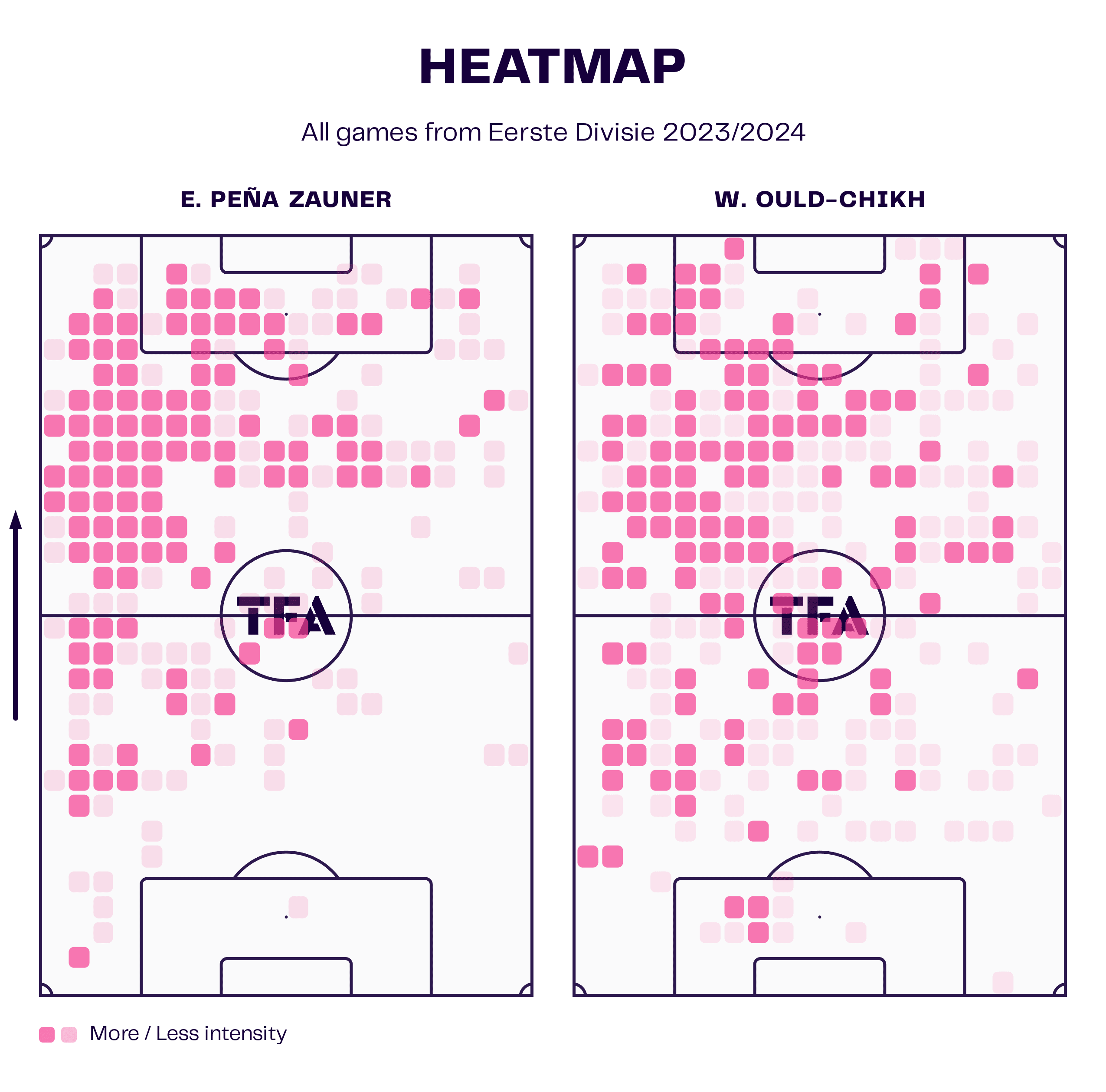
The data viz graphic above shows the heat maps from both Roda players this season, highlighting the areas they have both operated in thus far. Under Bas Sibum, Roda have tended to set up in a 4-2-3-1 formation, with Peña Zauner operating on the left side of midfield and Ould-Chiki through the centre. The German-born Venezuelan has tended to find himself in the penalty area more often than the Dutchman, with this due to the rotations that often occur between the wide midfielders and central striker of Roda.
Though these two have stood out for Roda in the attack thus far this season, it should be noted that they are not the only two who have been impressive, with the majority of the Roda attacking players chipping in with goal contributions through these first seven matches of the new season. Under Bas Sibum, the Roda attacking midfielders and forwards have all played vital roles in how Roda have looked to attack, with positional rotations up top and pushing numbers onto the backline causing plenty of issues for opposition sides defensively.
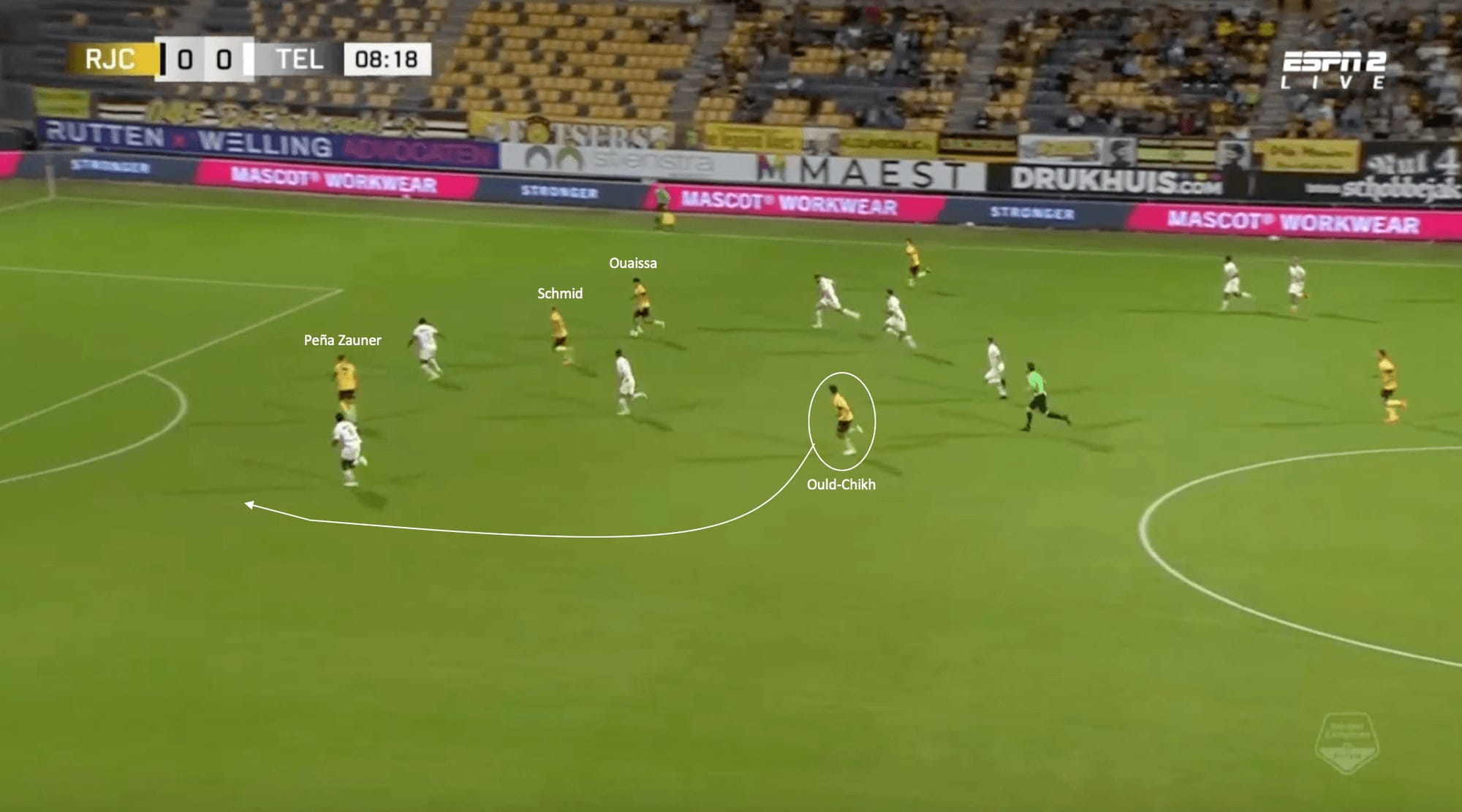
The image above shows the trouble that Roda’s attacking quartet has been able to cause for opposition defences throughout the early days of this season. The ball is in the possession of Sami Ouaissa, with the 18-year-old driving into the final third. Maximilian Schmid and Peña Zauner are occupying central positions, with their movements off the ball to tuck inside, forcing the Telstar defenders to come narrow and prevent the 3v1 that is beginning to show.
This allows Ould-Chikh to make a late run off the back shoulder of the last defender, with the Dutch midfielder finding himself in a deeper starting position due to his tendency to look for pockets in the opposition midfield. As the play develops and becomes more dangerous, Ould-Chikh’s positioning allows him to receive the ball unmarked just inside the penalty box.
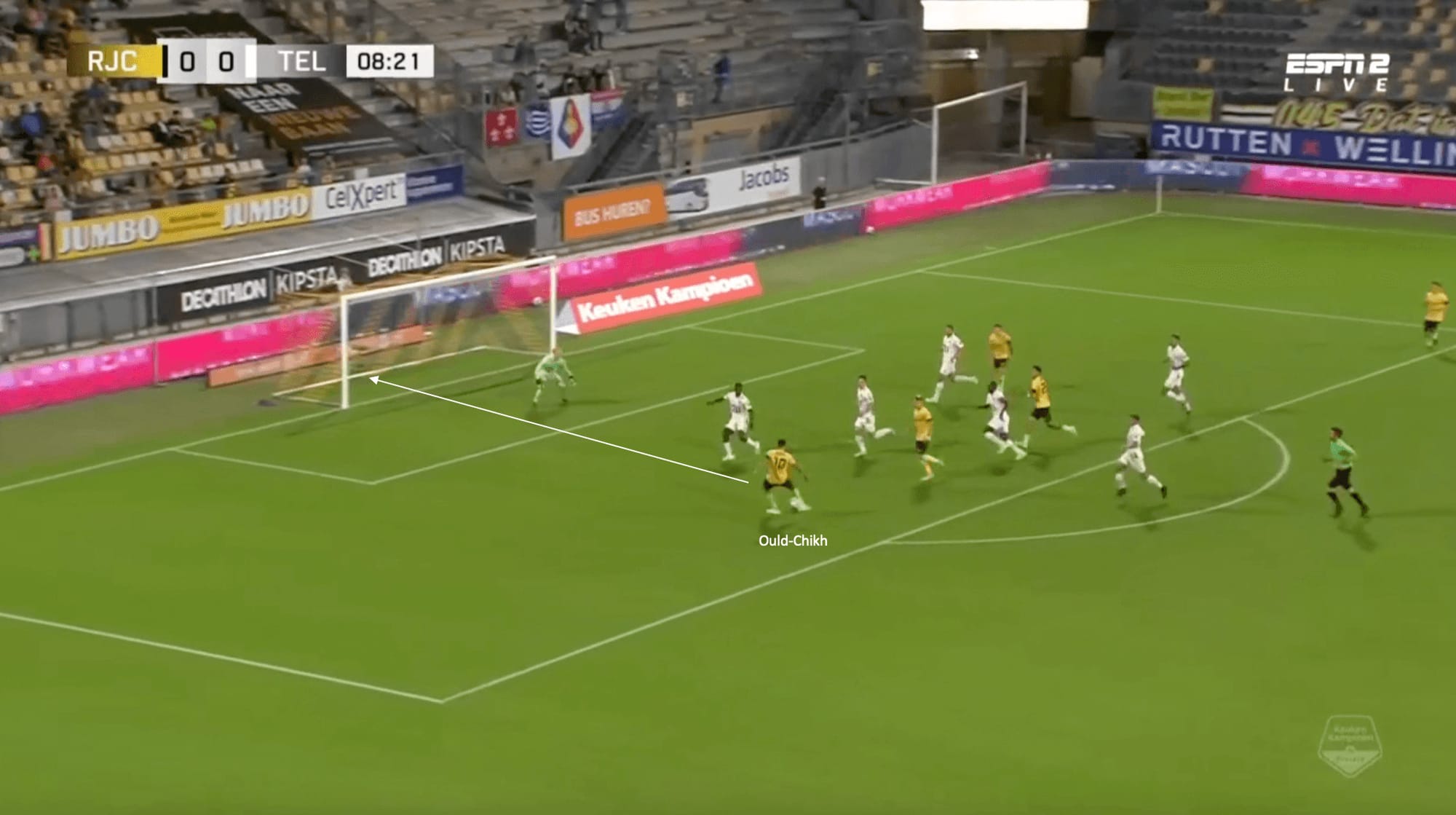
This next image shows where and when Ould-Chikh gains possession after a ball across the box from Ouaissa. As we can see, the attacking midfielder has been able to create space for himself to get a shot off after receiving possession. This goal from the 23-year-old results from his intelligent movement off the ball and waiting for the play to develop further before getting involved.
With the other three Roda attacking players converging on a more central position and sucking in the Telstar defence; as a result, it allows the Dutch midfielder to recognise this and keep the width for Roda, finding the space in an advanced area and still being between the posts to get a quality shot off and past the goalkeeper.
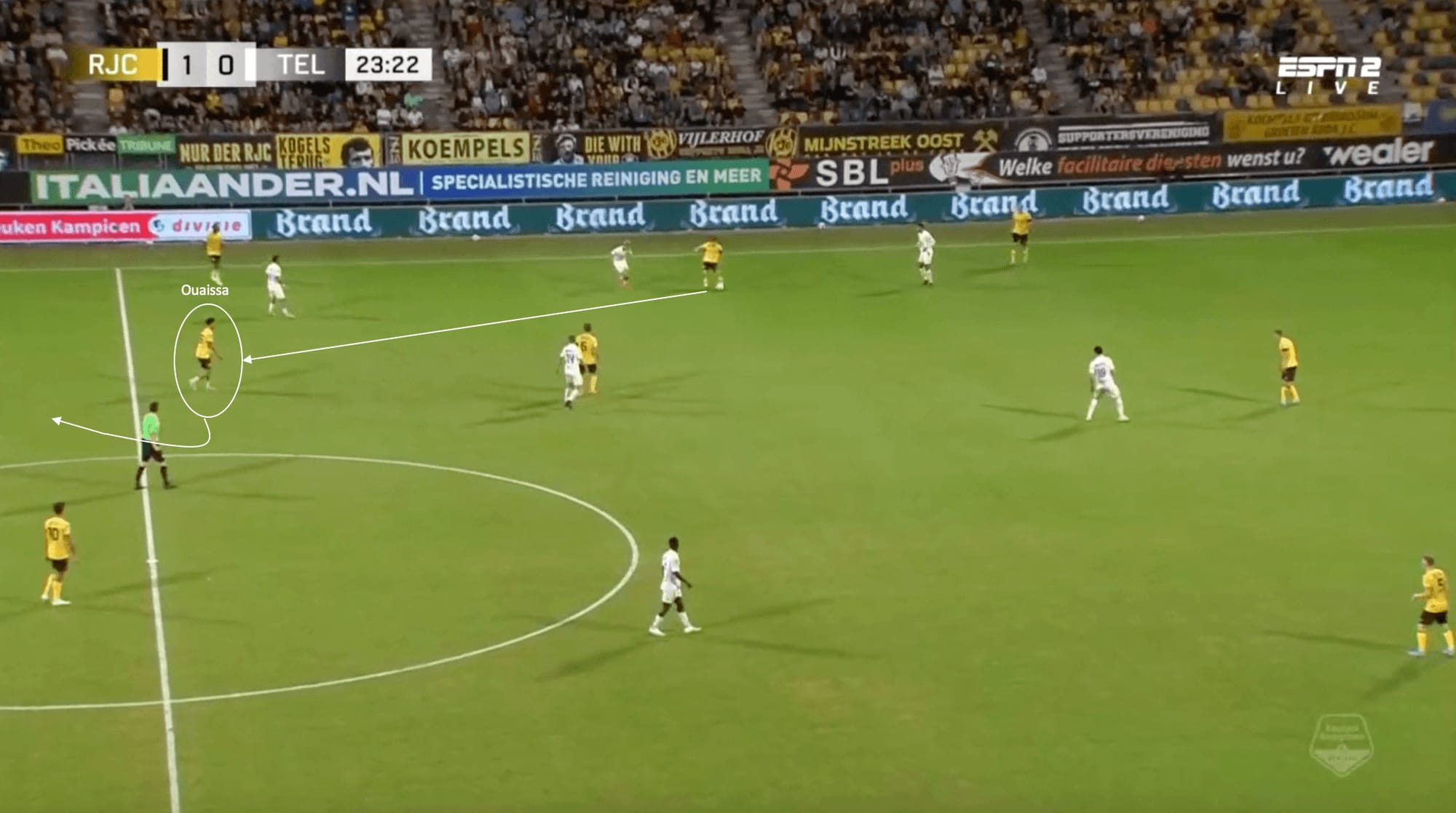
The image above shows another attacking image from the same match against Telstar, highlighting the pockets of space the attacking midfielders look to find and the positional rotations to confuse opposition sides. In this phase of play, Ouaissa had managed to find a pocket of space between the Telstar lines, with the ball into him splitting the stretched opposition midfielders.
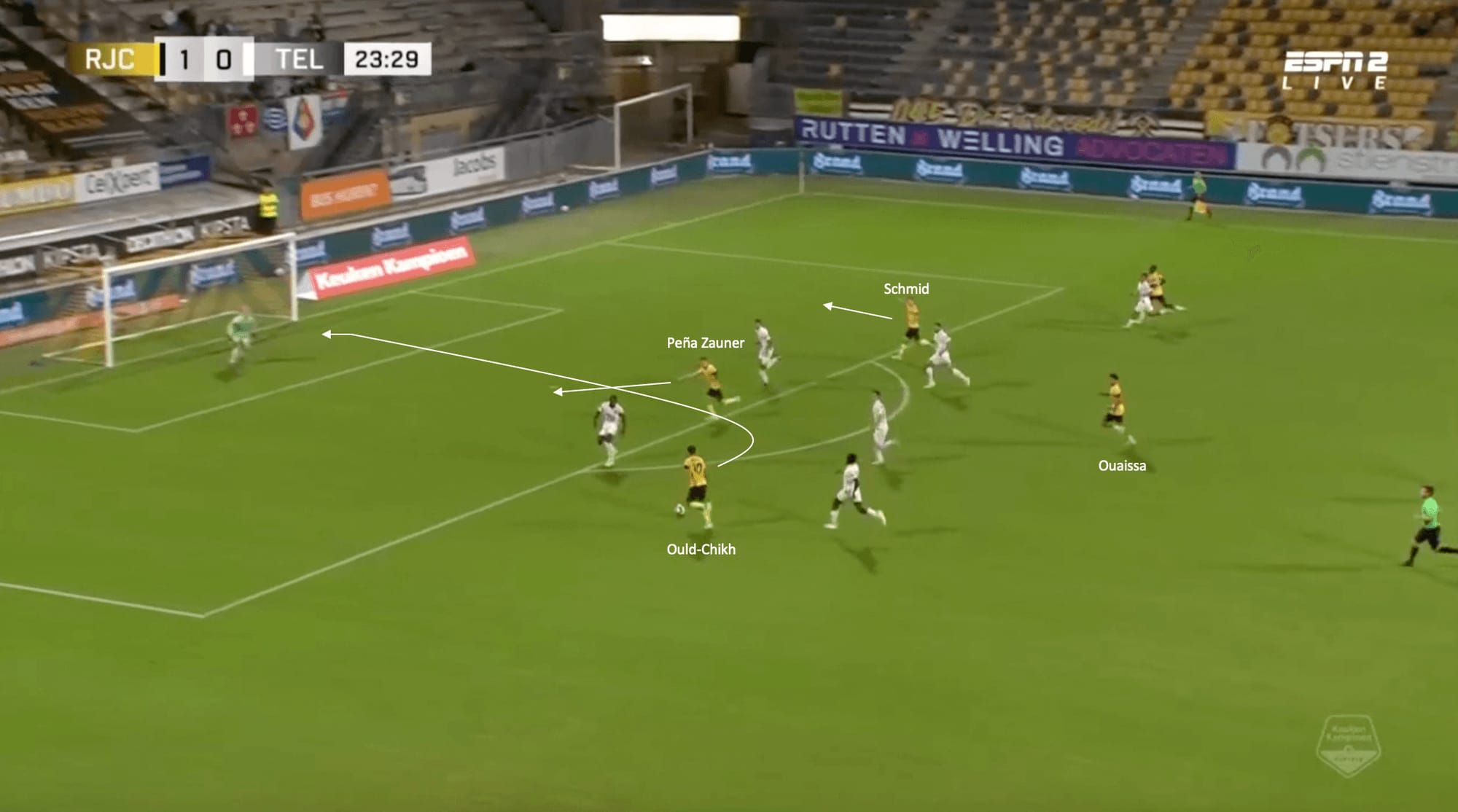
The image above shows the next phase after Ouaissa receives possession in the pocket of space. The 18-year-old is able to carry the ball into an advanced position before eventually laying off to Ould-Chikh, who has found himself in a slightly wider attacking position. Schmid and Peña Zauner are occupying the backline, with Schmid making a back post movement to keep the defender from sliding over to cover for the run of Zauner. This slight change of the run from Schmid keeps the back post defender honest, with him covering the space and dissuading Ould-Chkih from playing a potential chipped ball towards the back post.
The run from Peña Zauner creates an overload against the Telstar defender, with the Venezuelan being on the goal side of the defender. The run drags the defender out, allowing Ould-Chikh to get a shot off on target. Though the goalkeeper saved the shot, this goalscoring chance resulted in higher up the pitch, starting with the clever movement of Ouaissa to find the pocket of space in Telstar’s midfield.
These attacking rotations are not new, as many attacking-minded head coaches use rotations in the attacking half to drag defenders out and create pockets of space for attacking players to receive possession in. What Bas Sibum’s side have been able to do is use these consistently, with them being able to create multiple attacking chances a match with the off-the-ball movements of their attacking midfielders and forwards.
A look at the defensive side of the ball
Regarding the defensive side of the ball for Roda, Bas Sibum’s side has the joint-best defence in the Eerste Divisie, with four goals conceded through the first seven matches. A lot of this defensive success starts from the front, with their press one of, if not the best, in the Dutch second tier this season.
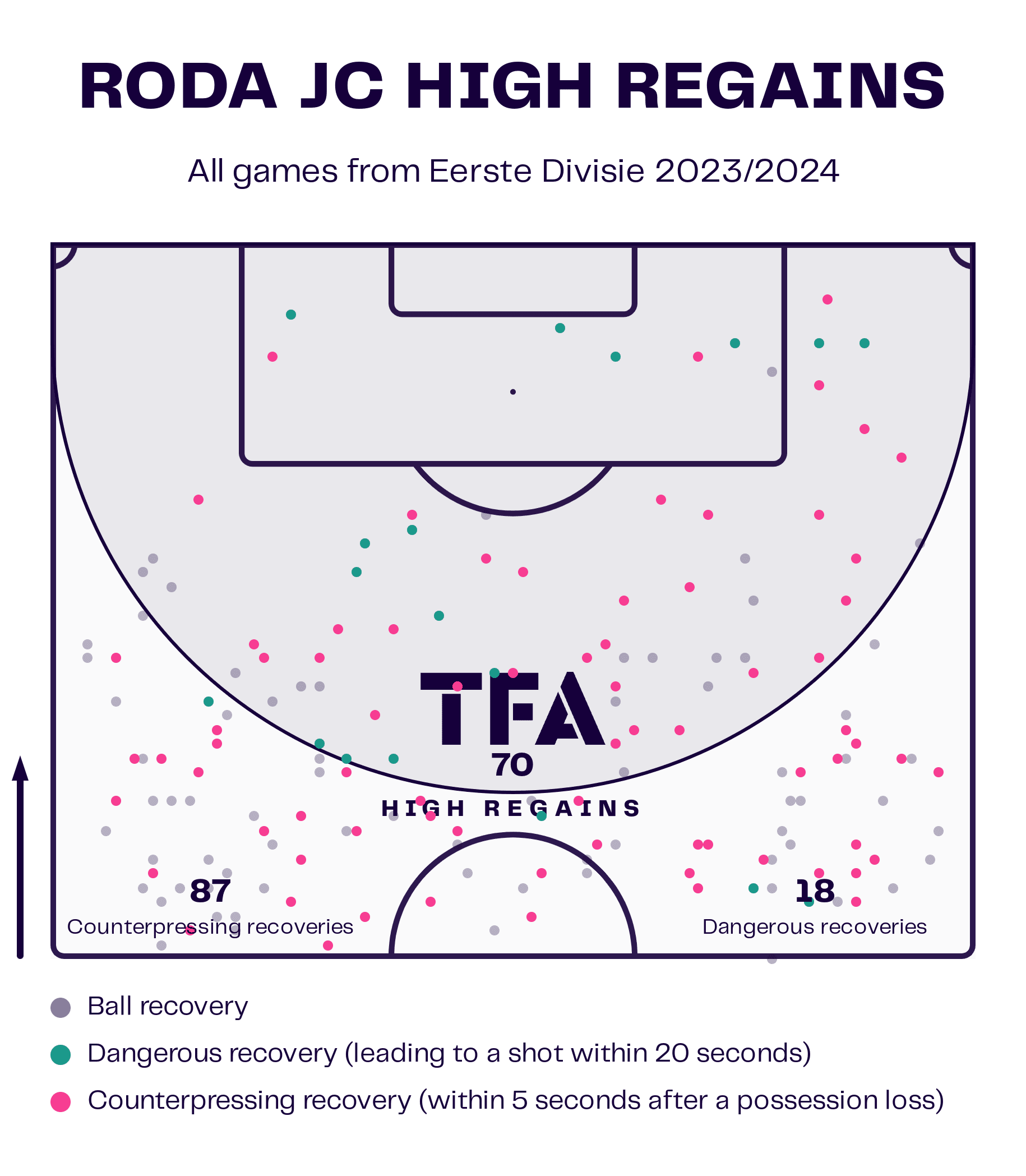
The data viz graphic above shows the high regains of Roda this season. As the picture illustrates, the Dutch side are very active in the pressing side of the game, with Roda having 70 high regains and 87 counterpressing recoveries through the first seven matches of the season. Roda looks to push plenty of numbers forward when the opposition is looking to build play out from the back, which sometimes leaves them exposed in the back due to the numbers they commit to the press.
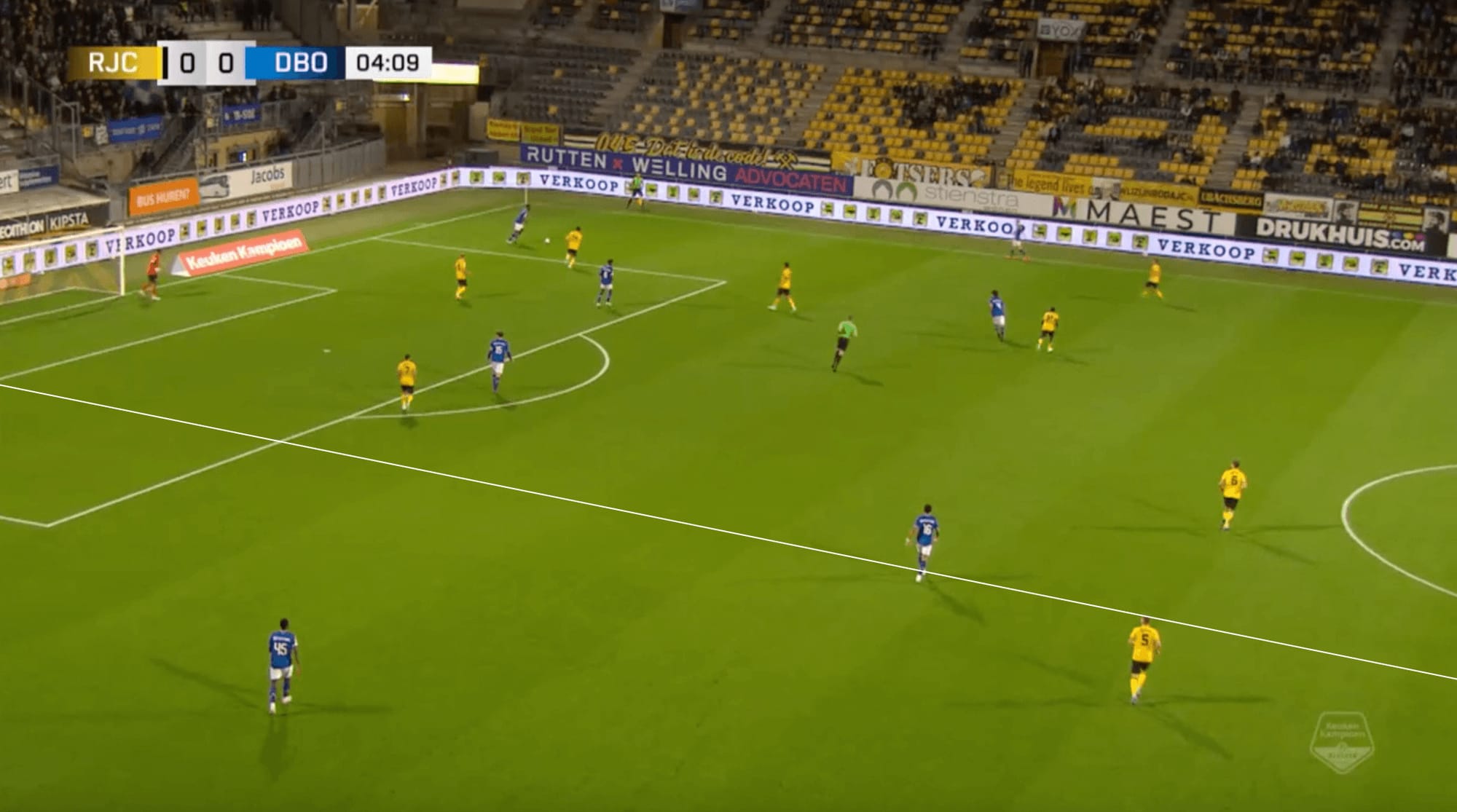
The image above shows a pressing phase from Roda, who is in yellow. The opposition, Den Bosch, looked to build from the back, with the ball coming from the goalkeeper to the outside centre-back currently in possession. Roda does well to shift over, essentially eliminating the switch and keeping the ball locked to one side. The line drawn through the pitch shows just how many numbers Roda has committed to keeping the ball locked to one side, with the only outlet on the switch being a virtually impossible diagonal ball.
With Roda doing well to be able to lock the ball to the far side, it makes what Den Bosch does next somewhat predictable for the Dutch side. The ball could be played to the wing-back who has tracked back but can be easily closed down and is hugging the touchline or playing it long to where the Roda central defenders are tightly marking the Den Bosch forwards. The defender opts to play long, with the Roda defender able to win the header and send it back to where it came from. The ball can fall to a Roda player in the attacking half, who attempts to start an attacking transitional phase due to the numbers they have already committed forward for the pressing phase.
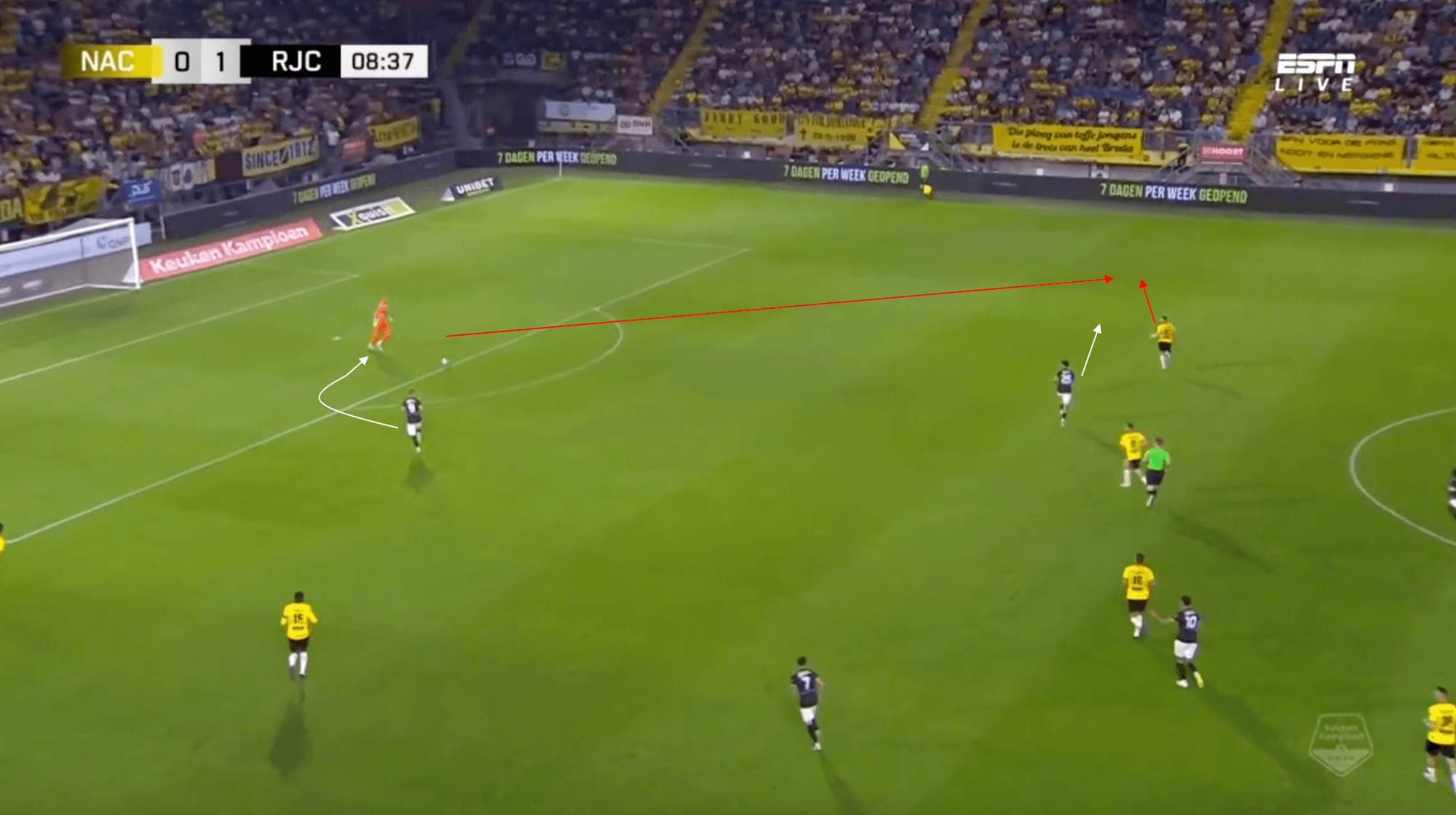
The image above shows another pressing phase for Roda, where they do well to force the play to one side before locking it. In this phase of play above, the ball is played back to the NAC Breda goalkeeper, who is put under pressure pretty quickly by the Roda forward. One thing to notice is how Schmid is able to bend his run when pressuring the ‘keeper, which locks the play and forces the ball to be played to one side.
Recognising the cue, the other Roda players in advanced positions shift to the far side, looking to regain possession once the ball is played to the NAC Breda defender moving wide to create an angle for the goalkeeper. This player receives the ball but is left with minimal options to continue progressing the ball forward into the attacking half.
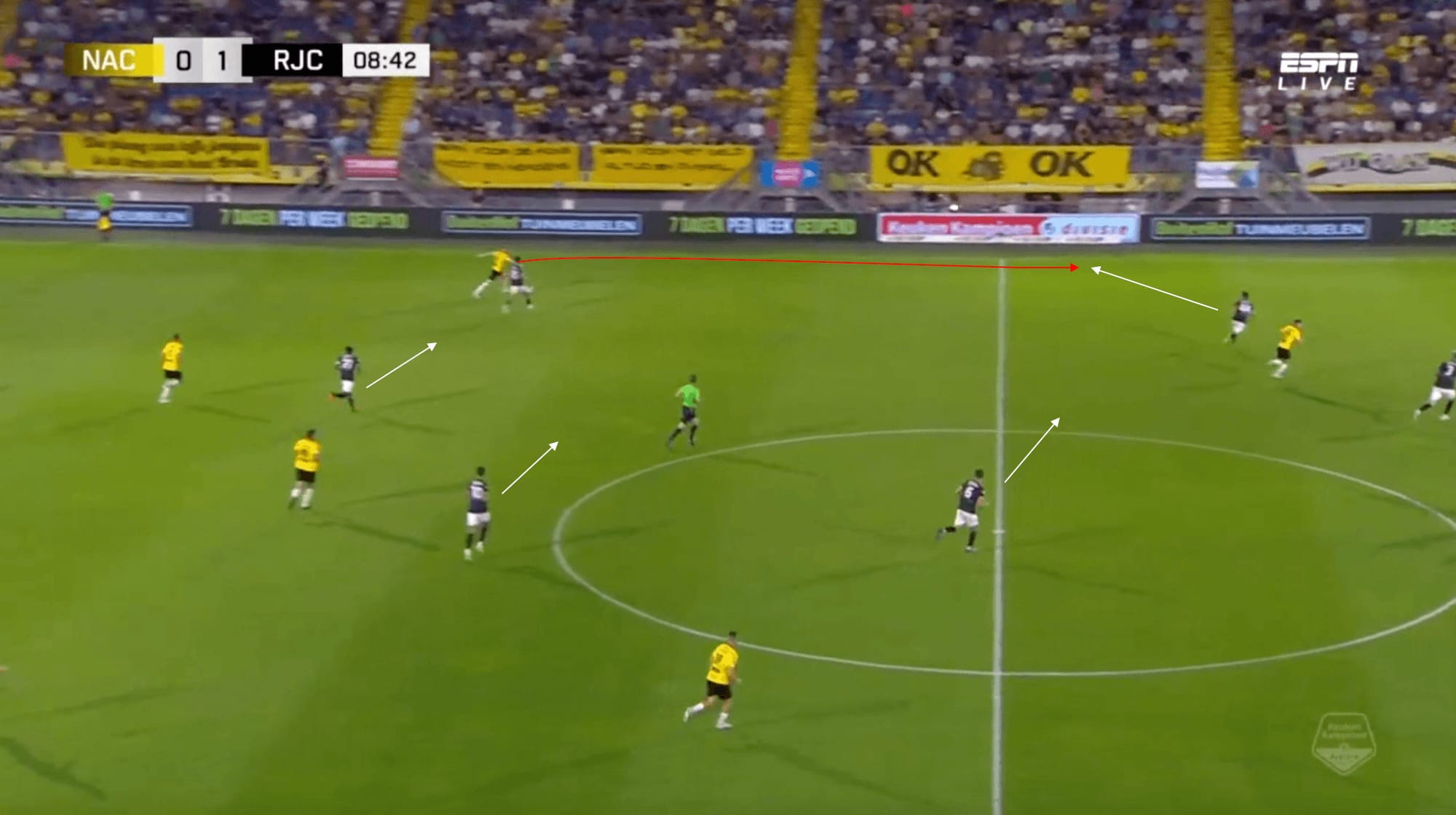
The image above shows the phase of play after the wide player for NAC Breda receives possession. As we can see, the Roda side have shifted over, locking the ball to one side and making the decision for the player in possession about where he is going to play the ball. Recognising where the ball is going, the Roda fullback is able to get into the passing lane, intercepting the pass and beginning a counterattack for Roda just beyond midfield in the defensive half of the pitch.
As this section has shown, while Roda do have the best defensive record in the Eerste Divisie to start this season, a lot of the defensive work starts higher up the pitch. The advanced players for Roda look to lock the ball to one side, pressing in advanced positions and looking to win back possession in advanced areas to counterattack with numbers already forward.
Conclusion
As this tactical analysis and scout report has shown, Roda deserve to be at the top of the Eerste Divisie after the start they have had. The future looks bright under Bas Sibum, with the hope and expectation that the Dutch side will return to the Eredivisie next season after over half a decade away.





Comments